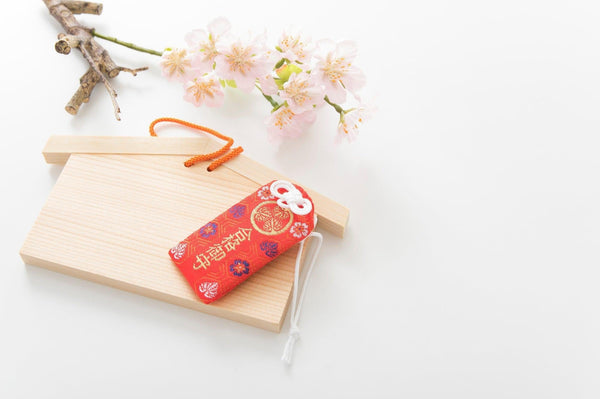
Jump to:
If you have ever wandered around a Shinto shrine or Buddhist temple in Japan, you may have noticed the brightly colored intricately-embroidered objects the size of name tags that are sold there. These are what Japanese people call Omamori, and they are similar to the amulets or good luck charms found in many other cultures.
In this article, we will look at what Omamori are, have a look at their history and how their form has changed over time, consider the main types, and various rules regarding their carrying, return, and disposal. Following that, we shall look at some recommended places to pick up some rare or unique Omamori and round up by looking at options for purchasing Omamori.
What Is An Omamori?
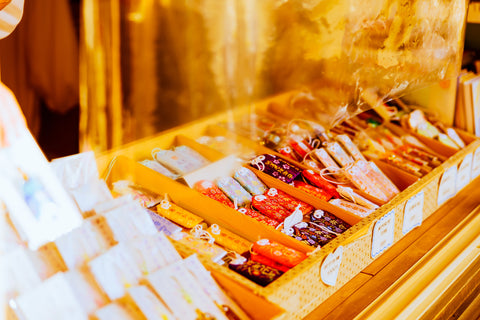
The word Omamori comes from the Japanese verb “守る“, pronounced “Mamoru”, which means “to protect”. It basically consists of an “ofuda”, which is a slip of paper or card in which a prayer or invocation is written. The priest (or in some cases a manufacturer) will then wrap the “ofuda” in a silky cloth or bag and stamp it with the name of the shrine or temple. Then, after attaching a string, the priest will pray over the Omamori before it is sold. Whereas there are general use Omamori available at any time, there are also Omamori for specific events and others that can only be purchased during a certain period of time.
The price of the Omamori depends on various factors, including the shrine or temple they are from and the style of the charm, as well as the level of ornate detail. Having said that, they usually cost at least ¥300 and go up to about ¥1,000, with the majority in the ¥500 to ¥800 range.
History Of Omamori?

So, how long has the Omamori actually existed in Japan? Well, its roots appear to go back to the Jomon period of Japan (14,000-300BCE), in which stone jewels called Magatama were worn on the person to ward off evil spirits. These are clearly very different from what we know of as Omamori today. From around the 6th Century, when Buddhism spread to Japan, amulets were distributed in temples.
However, it was not until the Heian period (784-1185AD) that the word Omamori began to appear in literature. One of the more famous examples is in The Tale of Genji by Murasaki Shikibu, which is one of the most famous ancient Japanese works and relates the story of Genji, the son of the emperor. At one point, Genji suffers from a deep fever, and his condition only improves when a hermit is sought out to provide him with an Omamori, which is swallowed by Genji and helps him to recover.
By the Tokugawa period (1615-1867 A.D.) people started to carry around charms purchased from religious institutions on their person in a way that they became inconspicuous to others, such as around their necks, in their pockets, or inside small cases that hung from their obi(belt). These Omamori resembled the standard Omamori we know of today.
In recent times, however, Omamori have gone through a further transformation with the influence of Japan’s cuteness culture. As many visitors to Japan know, the lure to make things look cute is seemingly irresistible in Japan (a study in 1992 found that “Kawaii”, meaning “cute”, was the most widely used, widely loved, habitual word in modern living Japanese), and Omamori have not escaped its clutches either. Visitors to shrines and temples will now find Omamori made out of cute Chinese zodiac figures or popular characters such as “Hello Kitty”.
The Main Types Of Omamori
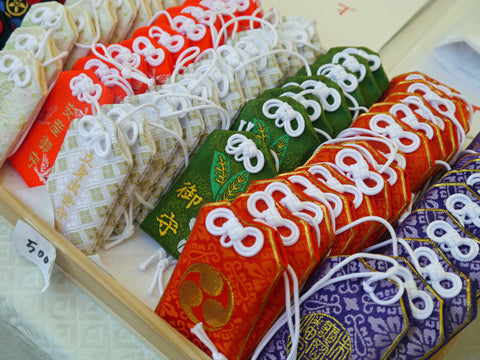
Although there are countless different types of Omamori available, the main categories have been listed below.
Education (学業成就)
The “gakugo-joju” Omamori is carried around by students preparing for important exams, as it is supposed to bring good fortune in relation to learning.
Health (健康)
The purpose of this charm, pronounced “kenko” is to protect the health of the recipient, protecting them from disease, and leading to a long life.
Safety (安全)
The “Anzen” range of Omamori are designed to keep the recipient safe in various situations. These included “Kotsu-anzen”, or safety while commuting, which people often hang in their cars, and household safety.
Money(商売繫盛)
This amulet, significantly often colored yellow to resemble gold, is said to provide you with prosperity and good fortune in your business, whether you are an individual or a corporation.
Love (縁結)
The purpose of this Omamori is to help you discover your soulmate, bringing you good fortune in romance, love, and, if all goes well, marriage as well.
Once you have found your partner, the “Meoto” Omamori embody the wish that you will be with that partner until death do you part.
Safe Delivery (安産)
The purpose of this charm is to ensure a safe delivery of your baby. There are also charms given to people who are couples who are hoping to conceive children.
Warding Off Evil (厄除)
These are charms used to keep evil away if the year is predicted to be a bad one for you (厄年), pronounced “Yakudoshi”, or you feel you have not had good luck in a long time.
Rules Of Omamori
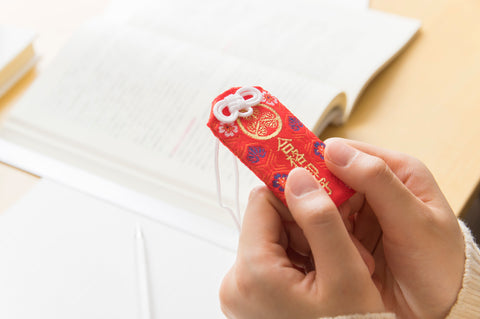
When it comes to Omamori, it is not only about choosing the right one. There are certain rules that need to be followed both during and after use. It is said that failure to adhere to such rules can mean the Omamori loses its effectiveness, or even have a negative effect.
Never Look Inside
A very important rule is that you should never open an Omamori that contains a prayer. Opening it and looking inside will cause the prayer to lose its power and this will nullify its fortune-bringing properties. It is said that, as it is impossible to know exactly what is inside, Omamori draw their power from the mystery of the unknown. Opening it causes all the mystery to disappear, and with it the protective power that it offers.
Omamori Have An Expiry Date
When you buy or receive an Omamori, the benefits do not last indefinitely but generally expire within a year. The exception to this is Omamori for specific events, such as the safe delivery of a child or exam success, which expire as soon as the events in question are over. And once the Omamori has expired, you must not merely throw it in the trash, but return it or dispose of it properly.
Returning Your Omamori
If possible, you should return your Omamori to the shrine or temple where it originated. If you can visit the shrine or temple in question, find the area marked “古礼収所”(Korei-shujo) or “古礼受付” (Korei-uketsuke) and drop off the charm. You should also consider making a donation at the same time. The next best thing to dropping it off in person is to send it by post to the shrine or temple, marking the package “お炊き上げ希望”. You should note however that not all institutions allow the return of Omamori by post, so check with them first.
If you cannot do either of the above, you should take the Omamori back to another temple or shrine. However, make sure that do not drop off Omamori that originated from a shrine at a temple, or vice versa.
Disposing Of Your Omamori
Another option is to dispose of your Omamori, but this must follow a set procedure and requires special materials.
- Spread out white hanshi paper (rice paper or calligraphy paper on the floor).
- Place the Omamori on the paper.
- Sprinkle salt on the left side of the Omamori, then the right, then the left once more.
- Wrap the Omamor in the paper and dispose of it (including by burning).
- Express your thanks during the process.
Rare Or Unique Omamori
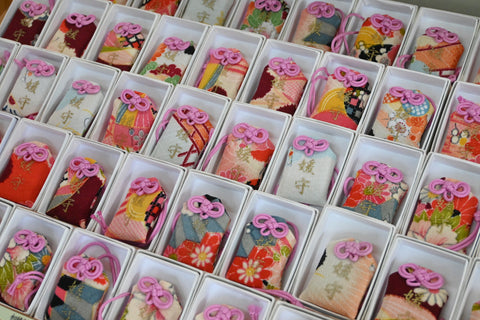
In this section, I would like to introduce you to a few temples or shrines where you can pick up some rare or unique Omamori.
Mimurotoji Temple in Uji, Kyoto
This temple in Kyoto is famous for its seasonal flowers, and these are used as a theme for the design of its Omamori. The most popular charm here is the “Heart Hydrangea Charm”, the purpose of which is said to be to make sure your love becomes requited.
Nishikitenmangu Shrine, Kyoto
This shrine is located within a market. It has a wide range of unique Omamori, including pet charms, friendship amulets, and a Daigan plum Omamori for the Shinto god of scholarship, Sugawara no Michizane, who was said to have loved plum blossoms.
Kanda Myojin Shrine, Tokyo
The “Shop Iki Iki” within Kanda-Myojin shrine features a wide range of Omamori that cannot be found anywhere else, including some created as a result of a collaboration between the shrine and gaming/anime companies. In addition to Omamori, they also have stamp books and sweets that use such characters as the basis of their design, so it is definitely worth a visit if you are looking for souvenirs.
Samuhara Shrine, Osaka
The hardest Omamori to get hold of in Japan can be found at Samuhara shrine in Osaka, where rings are engraved with four mystical characters on their insides. Each person is limited to purchasing one ring that fits on your fingers.
Options For Purchasing Omamori
The easiest, and most authentic way, of purchasing Omamori is from the gift shops and stalls of shrines and temples. If you don’t have an opportunity to visit the shrine or temple in question, many such religious institutions now have their own online shops. Given the spiritual significance of Omamori, it is probably best to avoid buying them second-hand on reseller sites, such as ebay. If you are looking for a quick and easy Omamori-based souvenir, you should also check out these Japanese bookmark lucky charms from Isuke, made in collaboration with Kyoto University of Art and Design.
Omamori-The Good Luck Charm for Any Occasion

As we have explored in this article, Omamori have a long history in Japan and Japanese people see them as important tools for navigating and protecting them during the various stages of their lives.
Purchasing Omamori yourself at a shrine or temple is a truly Japanese experience, but make sure you also abide by the rules discussed above for handling and disposing of/returning your Omamori after it expires.
Have you found any interesting or unique Omamori in Japan? Let us know in the comments.


0 comments